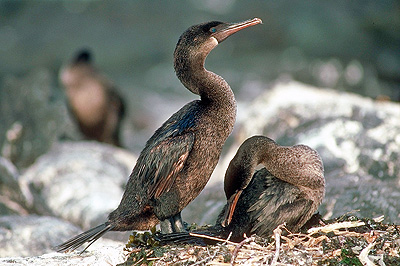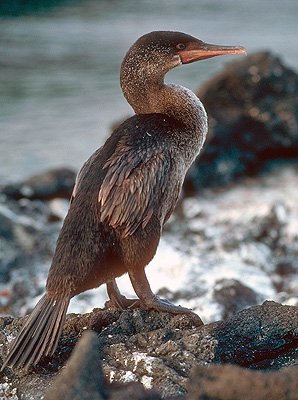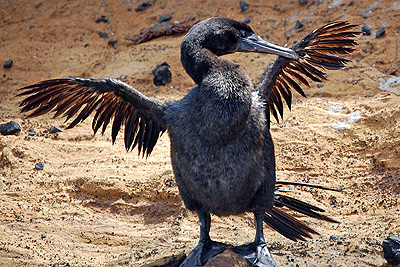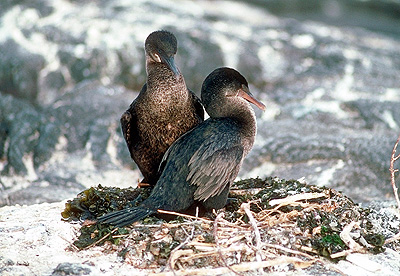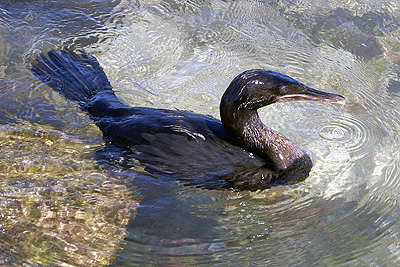A Galapagos Islands native and found no-where else, the flightless cormorant retains the swimming abilities of other cormorants but has lost the ability to fly. They have strong short legs with large webbed feet that are used for swimming, the much reduced wings are kept tucked away when underwater hunting prey.
Their feathers are not waterproof and they may be seen after dives standing in the sun with their small wings outstretched to dry. Found on only two of the islands in the group, the birds do not venture far from shore or their nesting site.
Flightless cormorant - Phalacrocorax harrisi
Profile - Animals of the Galapagos
One of the unique and characteristic species of the Galapagos and the only cormorant found there. They feed on small fish, eels and octopus that they catch during dives usually with about 100m of the shore line. They are quite drably coloured birds, blackish on top and brown underneath, they have beak that is hooked at the tip and a turquoise eye.
The Galapagos flightless cormorant is the largest of all cormorants and the only flightless species, the wings are about a third of the size that would be expected of wings that are large enough for flight. They swim very low in the water often with only their necks being visible from a difference. This low buoyancy helps them when it comes to diving an hunting along the sea-bed.
Flightless cormorant facts - Basics
Weight: 2.5 - 5 kg (5.5 - 11 lbs.)
Length: 89 - 100cm (2.9 - 3.3 feet)
Breeding: Nesting takes place from May
to October which is when sea surface temperatures are at
their coldest and when marine food is most plentiful. There
is an elaborate courtship ritual that begins in the water,
the birds hold their necks in a snake-like pose called "snake
necking" and the pair swim back and forth past each other,
they then proceed onto the land. Fairly typically for cormorants,
they build a large and bulky nest from seaweed and other
flotsam, mainly built by the male as part of the courtship
ritual where he brings pieces of nesting material to the
female as courtship offerings. Three eggs are generally
laid, though usually only one chick will survive, incubation
is around 35 days and the chick will reach independence
at about 70 days old.
If food is plentiful at this
point, the female will leave the male who will continue
to care for the chick for up to nine months while she mates
with another male an rears another chick, so females but
not males may have several broods a season, this is however
an infrequent occurance.
Estimated world population: - Fluctuates quite quickly over a the period of a few years, can fall during El Nino events but recover quite rapidly afterwards. Over the last 50 years has varied from a low of 400 adults in 1983 to a high of 1.500 in 2005, now thought to be more or less stable at over 1,000 adult birds. In number terms it is one of the world's rarest birds.
Feeding: Dive for fish, eels, octopuses on the sea bottom, unlike other diving birds which may use flippers or wings underwater, the reduced wings are kept close to the body while swimming using the feet only.
Conservation status: Vulnerable, the population is small, geographically limited and susceptible to human disturbance.
Distribution: The coast of Fernandina (mainly on the east), and the north and west coasts of Isabela in the Galapagos only.
Predators: No predators on the adults, like any birds the eggs and young chicks may be vulnerable to native and introduced predators.
How did Flightless Cormorants Come to be on the Galapagos?
Of course the most striking thing about the flightless cormorants is that they are cormorants whose ancestors flew to the Galapgos Islands and established a breeding colony then over the years and generations, the cormorants began to lose their power of flight. Their habitat is free of natural predators and without many direct competitors.
Like the ancestors of the birds that were to become Darwin's Finches, the ancestors of the flightless cormorant found themselves in an unoccupied ecological niche. The advantages of flight were no longer really needed and the costs of those advantages became disadvantages. Being able to fly means a lot of compromises, if you don't need to fly, you don't need to make the compromises and so the cormorants that flew to the Galapagos evolved to become the flightless cormorants that are found no-where else in the world. Not flying and not being a distance swimmer means you are pretty much stuck at home when home is an oceanic island hundreds of miles from anywhere else.
The reduced wings are known as a "vestigial organ", an organ where evolution has acted to lose or reduce it. Once it gave an advantage, but now in different circumstances, the costs of maintaining that organ are a disadvantage and so it is lost. This idea of losing a previously evolved structure was a key idea for Charles Darwin when he was formulating his ideas on evolution.


